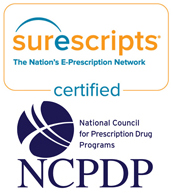1. The # 1 question asked by physicians concerning point of care medication dispensing: Is it legal?
Yes, every physician is allowed by law to dispense medications to his/her own patients within the practice environment. Under Stark regulations, physician dispensing is considered acceptable when the dispensing is limited to the physician’s own patients; and the medications and products dispensed meet FDA guidelines for re-packaging and labeling. There are only five states (Massachusetts, Montana, New York, Utah, and Texas) that have more restrictive laws concerning point of care dispensing; it is allowed, but limited.
2. What is Point of Care Dispensing?
Point of care dispensing is when the physician directly provides medications to their patient instead of handing their patient a prescription to take to a pharmacy.
3. Does point of care medication dispensing comply with state and federal drug dispensing regulations?
The MyRx® dispensing system complies with all DEA and FDA requirements. Repackaging companies are held to more stringent guidelines than pharmacies and all medications are repackaged in sterile environments to assure compliance.
4. What is Stark law? How does this affect me if I become a dispensing practitioner?
Stark law pertains to physician self-referral for Medicare and Medicaid patients. There are exemptions to this status for in-office ancillary services including physician dispensing. The in-office ancillary services exception of Stark law permits physician owners of a medical group, and other members of the group, to refer patients to their group for certain Designated Health Services (DHS). An outpatient prescription drug given to a patient in the physician’s office, but taken by the patient at home, is now covered by the in-office ancillary services exception.
To qualify for protection under the in-office ancillary services exception, the DHS must be furnished personally by the referring physician or another physician member in the same group practice or by individuals who are “directly supervised” by the referring physician or group practice member. The in-office ancillary services must be furnished in the same building in which the referring physician or a group practice member furnishes substantial physician services unrelated to the furnishing of DHS.
To qualify for protection under the in-office ancillary services exception, the DHS must be furnished personally by the referring physician or another physician member in the same group practice or by individuals who are “directly supervised” by the referring physician or group practice member. The in-office ancillary services must be furnished in the same building in which the referring physician or a group practice member furnishes substantial physician services unrelated to the furnishing of DHS.
5. What is the profit potential to my practice?
If your practice is using the MyRx® dispensing system by promoting it to all patients and encouraging use of the program, the profit potential can be significant. As with any program, utilization is the key. For a single physician practice seeing 30 patients per day on average, the annual income can range from $70,000-$125,000. Workers compensation costs and profit margins vary by state and will produce much higher margins.
6. Why have I not heard of this before, is point of care medication dispensing a new concept?
The practice of point of care medication dispensing has been around since physicians began practicing medicine; but a re-emergence as an industry began in the early 1980′s with repackaged drugs being introduced into the market. In 1983, a nationwide campaign lead by the retail pharmacy industry was begun with the intent to eliminate the physician’s rights to dispense. In 1985, legislation in Congress was passed in 46 states to secure the physician’s rights to dispense FDA approved medications to their own patients. The 1990′s dispensing systems were developing to make the process fast, easy and cost effective for the physician and now in the 2000′s with reimbursement cut backs to physicians and only a limited amount of time to see patients which decreases the chance of a physician increasing his patient load, physicians are turning to ancillary services such as dispensing to help increase their profit margins.
7. Does the physician need a special license to dispense medications in the office?
Most states do not require anything beyond your existing DEA and State license in order to dispense medications. There are a few states that have a designated dispensing license. In most cases it is offered at a minimal cost. MyRx® can help you in assuring you have all proper licensure to participate in your state(s).
8. How will point of care medication dispensing benefit my patients?
First and foremost is the convenience factor for your patients, no longer will they have to wait in long lines at a pharmacy to fill prescriptions. Filling prescriptions from your practice is an added service to your patients that saves them time and adds no additional cost. In many cases this can also mean a cost savings to the patient because no extra commute is required.
9. What if patients ask about our pricing versus their regular pharmacy?
MyRx® system communicates using the same technology that any major retail pharmacy uses in order to process a pharmaceutical insurance claim through the insurance payer. This allows for instant electronic confirmation of eligibility, patient copay and reimbursement to the practice. Therefore, a patient’s copay for brand or generic product is exactly the same as if they had gone to the pharmacy. Note that this program does not offer a $4 generic program. Most of these subsidized drug programs are limited to a select group of generic medications and days supply.
10. Who can dispense the medications in our office? Will I need additional staff to dispense?
In most states, a directive from the physician allows other staff members to dispense medications within the office. A few states do require that the physician actually do the dispensing.
11. What liability does the physician practice assume with point of care medication dispensing?
The liability is the same as it would be when a physician writes a prescription which is filled by a pharmacy. A general liability policy of 1/3 million in coverage is required. In point of care dispensing, there are stringent guidelines concerning packaging and labeling of the re-packaged medications. The MyRx® system meets all DEA and FDA requirements.
12. What if we have multiple physicians in our practice?
Having multiple physicians in a practice is not a problem, as each physician is assigned a specific password and can track their dispensing history separately for bookkeeping, documentation or patient information purposes. You can also have security access assigned at different levels to approved staff members who will be assisting in the dispensing process.
13. Will dispensing cause my malpractice premiums to increase?
No, whether a physician prescribes medications that are filled at a pharmacy or at his practice, the physician’s responsibility is the same. Malpractice carriers do not charge higher rates for dispensing physicians.
14. Do we have to file insurance for drugs dispensed in the practice? How do we handle Medicare and Medicaid patients? Drug cards?
While MyRx® offers and recommends the use of the insurance adjudication program it is not necessary to file insurance claims for medications dispensed in your office. The patient can always opt of using their insurance card and simply pay out of pocket- otherwise termed as a cash dispense.
15. Is the MyRX® software program easy to use? Will MyRX® train my staff and how long will the training take?
MyRx® dispensing software is a web based application. This means that any computer within the office that has an internet connection can be used as a dispensing terminal. The application requires minimal time, is easy to navigate and insures an accurate dispense. It features a drug utilization review for possible contraindications, allergies, conditions etc as well as generates bottle labeling and pharmacy education printouts. State mandated reporting is also compiled and submitted by the intuitive software application. MyRx® will provide complete training on the software and technical support when you have questions or concerns.
16. Is point of care dispensing efficient? How much time will it take my staff to dispense a medication?
The MyRx® dispensing program is easily integrated into your office procedures and is a streamlined process that can be completed between 30 seconds to 2 minutes depending on the level of information the physician requires on each patient. Trained staff can handle dispensing with minimal interruption to other office responsibilities.
17. Does the MyRX® program have a patient database with dispensing history?
Yes, patients are loaded in the database automatically when you dispense a medication and you can pull reports on dispensing history by patient, medication, date, etc.
18. How much time will it take to enter a new patient into the database?
A new patient can be added within 30 seconds to 2 minutes while dispensing, depending on the amount of information that the physician requests on each patient. Other demographic information is built into the system and can be added at time of dispense or at a later date if desired. This will vary with each individual office and the specific software programs in which the office participates. You do not have to add this additional information for a dispensing order to be completed.
19. Does the MyRX® program have an inventory tracking process?
The MyRx® program will automatically tell you when a particular medication is below the pre-set levels that will be determined by each individual office at the time of installation and training. You can re-order medications at the inventory site with the click of a button.
20. How secure is the MyRX® program?
A sophisticated password protection system is built into the MyRx® software. Each function performed by the software can be password protected to accommodate the needs and parameters of the individual physician practice. A double check system will not allow you to dispense a medication through the system that does not have a code match to the scanned bottle. In addition, the drug utilization review feature confirms with insurance pay or on previous dispense history.
21. Are the pre-packaged medications supplied as starter doses or full course doses?
Most dispensing physicians prefer to prescribe a full course dose of medication therapy to their patients, but starter doses can be dispensed in some situations.
22. How do we determine which medications and how many to order? Can MyRX® provide any medications I choose, including controlled substances?
MyRx® can supply any schedule 2-5 controlled substance as well as over the counter medications, injectables, and compounded medications. We suggest that initially you stock one week’s supply of the 15-20 meds you prescribe daily. This offering can always be expanded but it is best to start with a conservative inventory. The system will track all dispenses which will accurately determine which medications you are using most frequently and an accurate level of inventory control keeps your practice from running low on a particular medication. Your practice’s drug offering may develop over time and can change with seasonal practice activity.
23. How do we re-order medications?
MyRx®‘ dispensing program will automatically alert you of low inventory on specific drugs; these inventory levels are determined at the time of installation and training by the physician. When you receive a low inventory notice, you simply click a button to reorder that specific medication. You can expect delivery, under normal circumstances, within 3-5 business days from order submission.
24. Which medications generate the most income for the practice?
Generally, generic medications and drug products offer the most profit potential for a physician’s practice and the greatest savings to the patients.
25. What about theft?
The MyRx® dispensing process is managed in such a way that theft is rarely a problem. Password protection, an automatic inventory system and dispensing records of who dispensed make it difficult to hide theft of medications. Every container is accounted for in the inventory system and the reports allow the staff to easily and quickly determine if there is a problem; unlike the basic “supply closet” concept.
26. Why purchase re-packaged medications?
State and Federal regulations state that dispensing is allowed through the physician practice only if the medications are properly packaged and labeled. Products must comply to federally mandated current Good Manufacturing Practices (GMP’s) as noted in Title 21 of Code of Federal Regulations. Noncompliance with these laws could render the medication as “adulterated” and or “misbranded”. It is a federal crime to dispense an adulterated or misbranded medication to a patient.
27. Why are repackaged medications repackaged in negative airflow sterile rooms?
FDA reports that 50% of all drug reactions in the United States are caused by penicillin and cephalosporin contamination. It is almost impossible to get medications from a pharmacy that do not have some contamination of dust spores from penicillin or cephalosporin based medications as all medications are sorted using the same trays as the penicillin/cephalosporin based medications and cross contamination is a constant problem. One unit of penicillin is invisible to the naked eye, and many patients are highly allergic to penicillin/cephalosporin which can lead to anaphylactic shock. Repackaging medications in sterile negative airflow environments greatly decreases the chance of cross contamination.
28. What happens if there is a product recall from a drug manufacturer?
MyRx® software program can help you quickly identify any patients who are currently using a medication that has been recalled.
29. Who do I call if I have problems with software, medication delivery, regulatory questions, etc?
We at MyRx®, are service oriented and have technical support available at any time to help with questions and concerns, software problems and problems with medication orders. You will have contact information for a technical support staff member upon installation and training.




